1. Introduction
 The new generation of graphics cards is finally here and we get to test one. The AOpen Aeolus 7800GTX SLI enabled PCI-E has arrived at our labs (two of them to be exact as SLI implies), and we wasted no time testing this beast. So, we've seen how the 7800GTX performs as an SLI enabled card and now we will have a look at its performance as a single graphics card, against some of the other latest model cards such as the ASUS N7800 GTX TOP.
The new generation of graphics cards is finally here and we get to test one. The AOpen Aeolus 7800GTX SLI enabled PCI-E has arrived at our labs (two of them to be exact as SLI implies), and we wasted no time testing this beast. So, we've seen how the 7800GTX performs as an SLI enabled card and now we will have a look at its performance as a single graphics card, against some of the other latest model cards such as the ASUS N7800 GTX TOP.
- Packaging/Bundle

The Aopen 7800GTX retail box is quite impressive as you can see from the above picture. One can clearly discern the PCI-E and SLI logos, a clear indication to the prospective buyer of the slot interface type and SLI feature.
The retail package contains two full games, the Pitfall platform game, and a third person action game named Second Sight.
It also contains the VGA installation drivers and VideoStudio 7 software. The bundled software may be considered as minimal, but it is more than enough to get the VGA card up and working in no time.

There are also some accessories included in the retail package :
- DVI-CRT converter x 2
- Game CD x 2
- User's Guide : AOpen User's Guide x 1
- VGA driver disc : AOpen VGA driver disc x 1
2. Features
The 7800 GTX's main features as given by Aopen.
| GPU |
NVIDIA GeForce 7800GTX
Chip Technology : 256-bit
Core Clock : 450MHz
DirectX Generation : 9
|
| Video Memory |
-1.6ns
DDR3
256 MB
|
| Bus Type |
PCI-E |
| Highest Resolution / Colors / Refresh Rate |
2048x1536 / 32bit / 85Hz |
| RAMDAC speed |
400 MHz |
| Revolutionary 3D Accelerator Features |
Optimized DirectX and OpenGL acceleration |
| Connectors |
DVI connector x 2
TV-Out(S-Video) x 1 |
| Driver Support |
Direct3D, DirectDraw ,DirectVideo and ActiveX for Windows 2000/XP
DirectX : 8 / 9
SGI OpenGL ICD : Windows 2000/XP
|
| Software Package |
Auto driver installation wizard
User-friendly interface to control VGA settings
|
| Accessory |
Cable : S-Video to Compose cable x 1
DVI-CRT converter x 2
Game CD x 2
User's Guide : AOpen User's Guide x 1
VGA driver disc : AOpen VGA driver disc x 1
|
The RAMDAC speed is clocked at 400MHz. The default Core Clock is at 450MHz while the memory clock runs at 1.25GHz.

Key Features
- CineFX 4.0 Shading Architecture
This is a groundbreaking new hardware technology that pushes 3D real-time graphics one step closer to film quality. It offers infinite length shader programs, dynamic flow control, displacement mapping, vertex frequency stream divider and Multiple Render Target (MRT) technology. Previously, highly complex effects were not possible without sacrificing
performance and precision, because of long shader programs that required many
computational passes.
- SLI enabled
 NVIDIA® SLI™ (Scalable Link Interface) technology is a revolutionary approach to scalability and increased performance. NVIDIA SLI takes advantage of the increased bandwidth of the PCI Express™ bus architecture, and features hardware and software innovations within NVIDIA GPUs (graphics processing units) and NVIDIA MCPs (media and communications processors)
NVIDIA® SLI™ (Scalable Link Interface) technology is a revolutionary approach to scalability and increased performance. NVIDIA SLI takes advantage of the increased bandwidth of the PCI Express™ bus architecture, and features hardware and software innovations within NVIDIA GPUs (graphics processing units) and NVIDIA MCPs (media and communications processors)
- PureVideo Technology Support
 Watch videos on your desktop PC, notebook PC, or HDTV without the annoying artifacts and imperfections of traditional PC-based video solutions. NVIDIA® PureVideo™ technology delivers smooth HD video in all formats and with superb picture clarity. And the high-precision subpixel processing enables videos to be scaled to any size so that even small videos look like high-resolution videos.
Watch videos on your desktop PC, notebook PC, or HDTV without the annoying artifacts and imperfections of traditional PC-based video solutions. NVIDIA® PureVideo™ technology delivers smooth HD video in all formats and with superb picture clarity. And the high-precision subpixel processing enables videos to be scaled to any size so that even small videos look like high-resolution videos.
- UltraShadow II
More photorealistic scenes and environments in your games, without compromising PC performance. Complicated lighting and shadow effects become practical and next-generation games rise to the next level in cinematic realism.
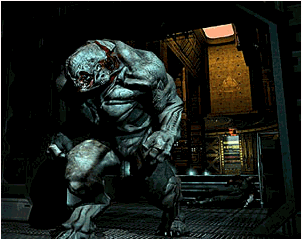 |
Ultra Shadow in all its glory... |
- E-Color 3Deep
E-Color 3Deep provides color and lighting correction to optimize your 3D gaming environment. 3Deep eliminates dark or washed out graphics for a key competitive edge in multiplayer games.
- Pixel Shader Model 3.0
Better performance and more realistic shades to produce high quality images within games.
- OpenGL 2.0 Support
- Up to D4 (1080i) Resolution High Quality HDTV Output
- DirectX 9.0 Support
- Dual Display Function Support
- NVIDIA Intellisample 4.0 Technology
3. A closer look
The Aeolus 7800GTX graphics card is quite impressive upon a first look. The Heatsink, seen in the photo below, is quite stylish, though no fancy flashing blue lights are present. The whole cooling system ensures low temperatures under heavy load, which is a promise kept by the Aeolus 7800GTX as we will see later on.

After removing the plastic heatsink cover, we can take a look at the metal fin design of the cooling system, which provides efficient heat dissipation leading to more effective cooling.

As with all latest generation cards, the 7800GTX requires an on-board power cable, which goes in the connector located at the front end of the card.

Here we can see a photo of the connections provided on the 7800GTX graphics card - 2 x DVI and one Vivo (HDTV) port is more than enough.

Now lets move to the next page where we cover in detail, our graphics card testbed.
4. Test System
- Processor: AMD64 3500+ NewCastle (939 socket)
- Case: Antec 1080AMG
- Motherboard: ASUS A8N-SLI Deluxe
- Memory: 2x512MB Corsair XMS TWINX1024-3200XL Memory
- Hard Disk Drive: WD800JD 80GB 7200RPM
- DVD Burner: Pioneer DVR-A08XLA
- Power Supply: EzCool 550Watt
- OS: Microsoft WindowsXP Pro SP2
- DirectX: v9.0c
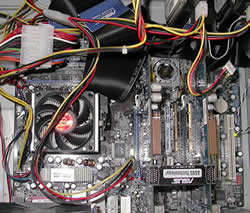
Benchmarking Software
3DMark05,03,01
Codecreatures Benchmark Pro
AquaMark3 v3.0
RivaTuner
Farcry v1.3
HL2
Doom 3
Thief 3
Ground Control II
Colin McRae '05
For comparison reasons, we will be posting the results of the Aopen Aeolus 7800GTX along with the results of the ASUS N7800 GTX TOP and the two previous generation technology top cards, the Aopen Aeolus 6800Ultra and the Sapphire X850XT.
5. 3DMark05
 With 3DMark05, Futuremark continues the tradition in its benchmarking software by providing a state-of-the-art Microsoft ® DirectX ® 9 3D performance benchmark.
With 3DMark05, Futuremark continues the tradition in its benchmarking software by providing a state-of-the-art Microsoft ® DirectX ® 9 3D performance benchmark.
3DMark05 is an all new 3DMark version making the most of Microsoft's DirectX
9. The previous version 3DMark03, did a nice introduction into this level
of technology. However
3DMark03 used DirectX 9 specific features in a limited manner, because fully
supporting hardware was rare at the time of its launch. In contrast, 3DMark05
requires DirectX 9 hardware with full support for at least Shader Model 2,
and takes shader usage to never before seen levels.
Just like its predecessors, 3DMark05's point system is set so that at the
moment of release, the high-end VGA cards available in stores can only score
around 5000 3DMarks, whereas the worst card that meets the programs requirements
yields a score of 1000.
Game Test 1 -Return to Proxycon
 Being the sequel to the "Battle of Proxycon"
from 3DMark03, in "Return to Proxycon" we're once again set in space
and the battle continues as space pirates invade a cargo ship in order to
take control of its valuable cargo.
Being the sequel to the "Battle of Proxycon"
from 3DMark03, in "Return to Proxycon" we're once again set in space
and the battle continues as space pirates invade a cargo ship in order to
take control of its valuable cargo.
This test, tries to simulate a future first-person shooter game with all the high details that entails. The dynamic shadows, high-detailed environment and advanced lighting techniques ensure that under normal circumstances, no recent card can run it with decent frame rates.
Game Test 2 - Firefly Forest
 A forest gets filled with magic fireflies in the night. The moon is nearly full, illuminating the forest with a bluish faint light. The magic fireflies have flickering bright green lights that playfully move around the forest.
A forest gets filled with magic fireflies in the night. The moon is nearly full, illuminating the forest with a bluish faint light. The magic fireflies have flickering bright green lights that playfully move around the forest.
This scene is a nice example of a smaller scale outdoor scene with rich vegetation. Immediate visibility is not so far, and there is a skybox surrounding the whole scene.
A large number of trees with their branches swinging separately, and dense vegetation being dynamically distributed according to the camera movements, make this test the most demanding of the three.
Game Test 3 - Canyon Flight
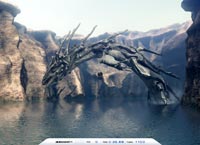 A Jules Verne type airship flies through a canyon guarded
by a dangerous sea monster. The airmen defend their ship using heavy cannons,
but these seem to have no effect on the huge sea monster. Finally the crew
manages a narrow escape using the "last resort" afterburners of
the airship.
A Jules Verne type airship flies through a canyon guarded
by a dangerous sea monster. The airmen defend their ship using heavy cannons,
but these seem to have no effect on the huge sea monster. Finally the crew
manages a narrow escape using the "last resort" afterburners of
the airship.
This scene is fairly complex with large areas of water
reflecting the high canyon walls. The water actually is one of the key points
of interest in this scene. The water not only does realistic looking reflections
and refractions, it has a depth fog, making the sea monster swimming under
the airship actually look deep down in the water. The air in this scene also
uses a volumetric fog, making distant cliffs of the canyon really look far
away.

As expected, the two latest release cards dominate in this test, with the N7800 GTX leading the race with a negligible difference of around 2 fps. Seems like the next generation graphics cards are up to the task.
Final Score
3DMarks on 3DMark05 are now calculated by the following formula:
(Game Test 1 * Game Test 2 * Game Test 3)^0.33 * 250
This is basically the geometric mean of the total frames in each
game multiplied by 250. This means that all game tests are now equal.

Take a look at these numbers. The N7800 and 7800GTX, both out in front with a sizeable difference, with the ASUS graphics card ahead overall by 500 marks. Notice the differences from the previous generation cards (which are still of course considered as "beasts", especially in SLI mode in the case of the 6800 Ultra).
6. 3DMark03
 3D Mark is a widely used and accepted benchmark that stresses the DirectX performance of a VGA card. A very strong point of 3DMark is that it's VGA card measuring is does not require any CPU power. So the resulting fps are a good reference a VGA card's rendering performance. For testing the performance of each card we used the 4 game benchmarks 3DMark has.
3D Mark is a widely used and accepted benchmark that stresses the DirectX performance of a VGA card. A very strong point of 3DMark is that it's VGA card measuring is does not require any CPU power. So the resulting fps are a good reference a VGA card's rendering performance. For testing the performance of each card we used the 4 game benchmarks 3DMark has.
3Dmark03 also includes sound and CPU tests as well as some other feature tests.
- Game Test 1 - Wings of Fury (DX7)

This test is a combat flight simulator written for older hardware (DirectX 7). Particles are used a lot in this test - smoke and vapor trails, flak and gunfire, and explosions are produced using point sprites and quads.
- Game Test 2 - Battle of Proxycon (DX8)

This test is a simulation of first person shooter game types. 1.1 and 1.4 Vertex shaders are widely used since all character models are skinned using vertex shaders.This makes this test a good vertex shader comparison for VGA cards.
- Game Test 3 - Trolls' Lair (DX8)

This test should be the favorite of all RPG lovers. It is a cut scene of a female warrior facing two malicious trolls. Again the same vertex and pixel processing is used as in game test 2.
This test also uses post-processing effects, such as Depth of Field and Bloom effects which are widely used in today's game cut scene sequences.
- Game Test 4 - Mother Nature (DX9)

Mother nature represents the level of effects and realism that are possible using 2.0 vertex and pixel shaders, plus some other features that DirectX 9 offers.
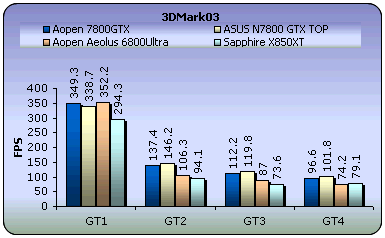
Surprisingly enough, the 6800Ultra gave the best performance in the first test, followed by the reviewed card and then the ASUS. In the rest of the tests, the reviewed card performed well, trailing only slightly behind the ASUS N7800 GTX with a difference of 5 or more fps.
- 3DMark Official score
If you test your machine with 3DMark, you can post the results at 3DMark's online result browser. For more information visit futuremark.com.

The Aopen 7800 produced an average of 16652Marks, to the 17461 Marks from its ASUS rival.
7. Codecreatures
 CodeCreatures is a synthetic 3D benchmark that is a good reference for VGA performance comparison. This is a high-end 3D benchmark that also requires DirectX 8 hardware, making a good tool for measuring the potential of DirectX 8 game performance.
CodeCreatures is a synthetic 3D benchmark that is a good reference for VGA performance comparison. This is a high-end 3D benchmark that also requires DirectX 8 hardware, making a good tool for measuring the potential of DirectX 8 game performance.
The Codecreatures benchmark is written with Microsoft's DirectX 8.1 API and incorporates the use of Vertex and PixelShaders popular on next generation 3D accelerators.

The benchmark plays a photo-realistic nature scene and calculates the performance of the graphics adapter by measuring the fps that it can display at 1024x768, 1280x1024 and 1600x1200 resolutions.
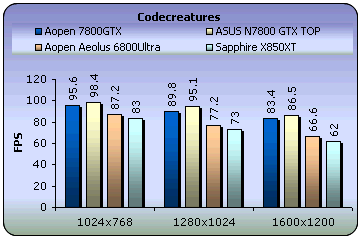
-Codecreatures number
The codecreatures number is the resulting score of the total
benchmarking process and is basically the geometric mean of the three frame
rates multiplied by 100.

As has been mentioned in past reviews, the nVidia Pixel Shader provides a boost to cards using this feature. The first two cards, the Aopen 7800GTX and ASUS N7800, use the latest version of Pixel Shader, version 4.0. Great performance in this test, although again the ASUS graphics card seems to have the edge over our reviewed card. Still, the differences overall can be considered as negligible.
8. Aquamark3 / 3DMark 2001
 Since the majority of today's applications and games are compatible with DirectX 9, the need of benchmark applications that use DX 9 has been brought up. The benchmark uses the 3D engine (Krass engine) of the Aquanox game.
Since the majority of today's applications and games are compatible with DirectX 9, the need of benchmark applications that use DX 9 has been brought up. The benchmark uses the 3D engine (Krass engine) of the Aquanox game.
Aquamark Triscore
The Aquamark Triscore comprises 3 values: the overall system performance, the performance of the graphics system and the CPU performance. Keep in mind that this is not the total result of the tests, but the result of the whole benchmark process including all 9 chapters.
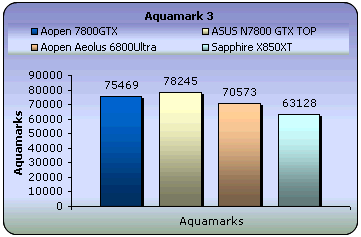
75469 is the final score for the AOpen 7800GTX, 3k aquamarks below the ASUS. Interestingly enough, the 6800 Ultra manages to stay within firing distance.
3DMark 2001
 is the predecessor to 3DMark03. It's mainly a directx8.1 benchmark and the score depends a lot on the CPU power of your computer. However for reference use only we decided it'd be best to just leave it in our benchmark list so you can compare the next generation cards with the possibly outdated you have at home.
is the predecessor to 3DMark03. It's mainly a directx8.1 benchmark and the score depends a lot on the CPU power of your computer. However for reference use only we decided it'd be best to just leave it in our benchmark list so you can compare the next generation cards with the possibly outdated you have at home.
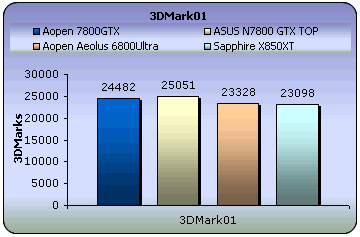
3DMark 01 is used merely for comparison reasons, as it is considered outdated. Once more, the reviewed card came in second to the ASUS card with a bit over 500 marks difference.
9. Half Life 2

Half life 2 is no doubt the most anticipated pc game of all times.
 Characters - Advanced facial animation system delivers the most sophisticated in-game characters ever seen. With 40 distinct facial "muscles," human characters convey the full array of human emotion, and respond to the player with fluidity and intelligence.
Characters - Advanced facial animation system delivers the most sophisticated in-game characters ever seen. With 40 distinct facial "muscles," human characters convey the full array of human emotion, and respond to the player with fluidity and intelligence.
Physics - From pebbles to water to 2-ton trucks respond as expected, as they obey the laws of mass, friction, gravity, and buoyancy.
 Graphics
- Source's shader-based renderer, like the one used at Pixar to create movies
such as Toy Story® and Monster's, Inc.®, creates the most beautiful
and realistic environments ever seen in a video game.
Graphics
- Source's shader-based renderer, like the one used at Pixar to create movies
such as Toy Story® and Monster's, Inc.®, creates the most beautiful
and realistic environments ever seen in a video game.
AI - Neither friends nor enemies charge blindly into the fray. They can assess threats, navigate tricky terrain, and fashion weapons from whatever is at hand.
To measure performance we used the Video Stress Test(VST) that is available in the CounterStrike:Source beta available through Steam. We set all the details to the highest level and each time changed the resolution from 800x600 up to 1600x1200.
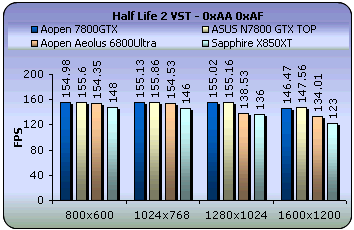
With AA and AF settings disabled, we measured the average framerate at each tested resolution. With these settings, performances do not differ between one another.
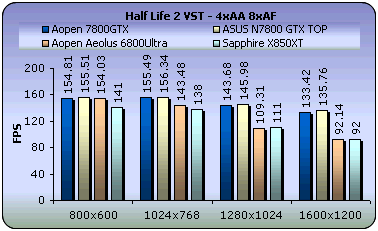
With AA and AF set to 4x and 8x respectively, once more, the results do not show major differences in performance between the two latest release cards. Note also, that as the resolution rises, so does the difference between the latest and previous generation cards.
10. Doom 3

A massive demonic invasion has overwhelmed the Union Aerospace Corporations? (UAC) Mars Research Facility leaving only chaos and horror in its wake. As one of the few survivors, you struggle with shock and fear as you fight your way to Hell and back, in an epic clash against pure evil.
Activision made it's miracle again with Doom 3 which is said to be the best-looking game ever, thanks to the brand-new OpenGL graphics engine used to generate its convincingly lifelike, densely atmospheric, and surprisingly expansive environments. If you are a fan of the previous Doom games then you will get many flashbacks with this revision, since you will find reimagined versions of almost every monster from both Doom and Doom II.

To measure performance on the game we used the timedemo demo1 command from the console (Alt+Ctrl+~).
Enabling the high quality setting and executing the timedemo demo1 command twice for each resolution, we witnessed the following:
First, without the Anti-Aliasing and Anisotropic Filtering settings
enabled, we got the following results:

Let's see how the cards perform with Doom3. Both AA and AF are off and the max framerates reported under 1600x1200 are 93.7 frames per second for the AOpen card, to the 97.9 fps for the ASUS. Really nice performance in comparison to the previous generation graphics card, where at the highest possible resolution, the difference in framerate becomes quite significant.
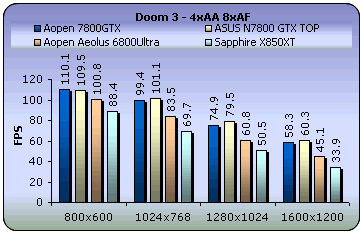
All advanced features enabled and the two 7800 cards reported more or less similar results. In comparison to the other two cards, there is a noticeable difference at the highest resolution which makes for very enjoyable gameplay. Great performance.
11. FarCry

 You are Jack Carver running your own boat charter business in beautiful Micronesia. With a past best left behind you, you'll be focusing on your present assignment: escorting an ambitious journalist named Valerie Cortez to the Island of Cabatu. It seems like a piece of cake, but you'll soon learn: paradise can be hell.
You are Jack Carver running your own boat charter business in beautiful Micronesia. With a past best left behind you, you'll be focusing on your present assignment: escorting an ambitious journalist named Valerie Cortez to the Island of Cabatu. It seems like a piece of cake, but you'll soon learn: paradise can be hell.
Farcry is an awesome First Person Shooter (FPS) based on a last generation 3D engine named as CryEngine. Real-time editing, bump-mapping, static lights, network system, integrated physics system, shaders, shadows and a dynamic music system are just some of the state of-the-art features that the CryEngine offers.
A great advantage and strong point of the CryEngine is its physics system which supports character inverse kinematics, vehicles, rigid bodies, liquid, rag doll, cloth and body effects. All physics seem to be very realistic and you never get bored when facing enemies, since character models have multiple animations that blend in believable ways.
With an integrated shader system and a massive terrain which maximizes
the view distance to 2km, these features make Farcry a perfect action game and
also a referable benchmark to speak of.
- Benchmark Settings
For this game we recorded a custom demo from the start of the Rebellion
stage. We chose an indoor scene in order to avoid getting the CPU bound effect. This will result in slightly higher results since it is also less
GPU intensive, but we can't afford being stuck at 40-50 fps because of our CPU.

The latest patch (1.3) was used for our tests which updates the
game's graphics engine to use the 3.0 Shader model. This option is only supported
for the 6800 series.

The resolutions we ran the demo under, are the following:1024x768,
1280x1024 and 1600x1200.

With AA and AF disabled, the differences are not significant between the two 7800 cards and the 6800Ultra. Traditionally, the ATI card does not perform well in FarCry as can be seen in the above table.
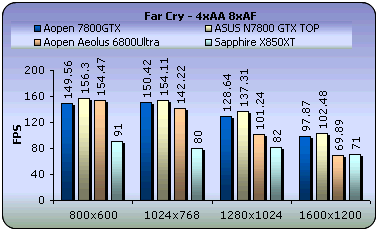
With AA and AF enabled, the AOpen card was slightly behind the N7800 ASUS card. In comparison to the 6800 and ATI cards, the difference in fps is considerable, especially at 1280x1024 and above.
12. Thief 3
 Instead
of Deus Ex from now on we'll be testing our cards using Thief 3. It's based
on the same engine but it's much less GPU intensive and playable by more VGA
cards than
Instead
of Deus Ex from now on we'll be testing our cards using Thief 3. It's based
on the same engine but it's much less GPU intensive and playable by more VGA
cards than  Deus.
Deus.
The game makes severe use of Pixel Shader 1.1 instructions, the bloom effect and stencil shadows to achieve a wonderful result in your screen.
In the game you play the part of Master Thief Garrett who is back to rule out any evil forces using his unique stealth abilities. Deadly Shadows shows what stealth gameplay is all about. This game really gives you the feel of sneaking around and holding your breath when stuck in a sticky situation.
Since there is no official benchmark for the game, we'll do our tests using
a GPU intensive scene from the tutorial-level which we believe that represents
the average fps you'll get when playing the game.
Thief 3 is a torture test for graphics cards. All lower class cards fail to provide stable performance in this benchmark when selecting full details from the settings menu.

With AA and AF settings disabled, the AOpen performed well in this test. Although it was second to the ASUS N7800 by few fps difference, in comparison to the other two cards, the AOpen 7800 is the card that manages to beat the 60fps limit of the Thief 3 graphics engine in single mode.
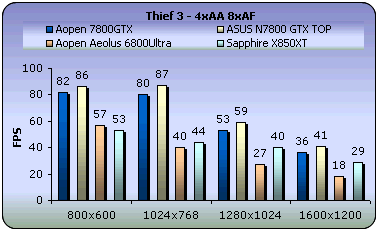
Once more the differences from the previous generation cards is clearly visible with AA and AF enabled. And once more the Aopen card came second to the ASUS. Seems like the higher setting of clock and memory frequencies on the ASUS N7800 gives it the edge.
13. Colin McRae 05
 For all you racing fans out there, this test is for you and will represent the Racing game category in our benchmarks.
For all you racing fans out there, this test is for you and will represent the Racing game category in our benchmarks.
From the graphics point of view the first thing you'll
notice in the game is the excellent amount detail of your racing car. High
resolution textures on the car and lighting make it quite impressive. All
the eye candy such as the sun reflection in the virtual camera are still the
same as the older CM versions but motion blur has been added when your card
hits something hard which will happen most often if you're new to the racing
simulation world.

To measure performance on the game we used fraps to get the average fps of the whole 8th stage of UK which is actually the only stage you get to play on the demo.

Good performance from both cards with AA and AF disabled. Once more the ASUS N7800 took the honours.

With AA and AF enabled, the ASUS N7800 manages to retain first place, while the reviewed card follows close behind and then significant drop to the 6800 and X850 cards.
14. Ground Control II
 Ground
Control 2 is an action-oriented game of tactics and warfare. As Captain Jacob
Angelus of the Northern Star Alliance, you will command squads of infantry,
artillery, and air power against the might of the Empire of Terra. Base building
and resource-collecting are replaced with unit control and combat tactics where
your knowledge of the battlefield maneuvers will make the difference in your
fight against a ruthless enemy. Position your troops on hilltops for better
aim or inside buildings and forests for protection as you'll need to use every
inch of terrain to your advantage.
Ground
Control 2 is an action-oriented game of tactics and warfare. As Captain Jacob
Angelus of the Northern Star Alliance, you will command squads of infantry,
artillery, and air power against the might of the Empire of Terra. Base building
and resource-collecting are replaced with unit control and combat tactics where
your knowledge of the battlefield maneuvers will make the difference in your
fight against a ruthless enemy. Position your troops on hilltops for better
aim or inside buildings and forests for protection as you'll need to use every
inch of terrain to your advantage.
For our benchmarks, we used the highest possible settings on the first mission
of the single player game and moved around the camera to get an average frame
rate using fraps.

Ground Control II offers really impressive graphics without requiring much GPU power. Click on the picture above to view a screenshot from the game. Check out these excellent water effects!
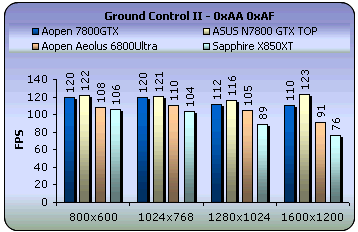
The ASUS N7800 is benefits greatly from the increased core and memory frequencies in comparison to the Aopen 7800. Notice the differences at the highest possible resolution.

Similar performance here, with the ASUS N7800 leading the way. Again, the differences at the higher resolutions is significant. Excellent performance from the Aopen 7800.

15. Overclocking
No matter your graphics card, there comes a time in your
computer's life when it can no longer cope with the latest technological
demands the ever so popular games impose. This is one of the main
reasons for overclocking your graphics card. Gamers are always looking forward
to
a
little extra
boost in terms of framerate. Even though most of the times the boost is far
from noticeable, overclocking remains the last resort when you can't afford
to buy a brand new VGA card.
The default frequencies for the Aopen 7800GTX are 450MHz for the Core and 1250Mhz for the Memory. We tried to push these frequencies while maintaining valid and stable performance, finally maxing out at 499MHz for the Core and 1390MHz for the Memory, whence the tests were carried out once more. We compared the results between the default frequencies and with the OC and this is what we got.
Let's see how much of a difference in performance we achieved.
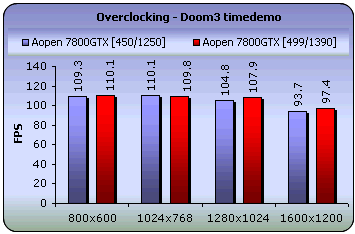
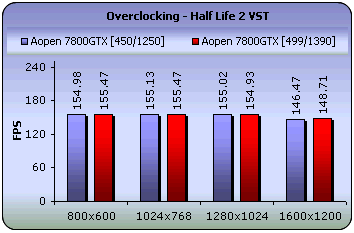
Unfortunately, in both cases (Doom3 and HL2), the difference between default and OC is no more than 4-5 fps. Note that the OC version of the 7800 (which we achieved here), is now the same as the ASUS N7800's default Core and Memory frequencies.
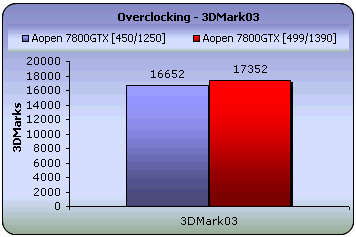

The OC 7800GTX reached the performance of the ASUS N7800 as it can be seen in these graphs. Even though performance did not dramatically increase in terms of fps, some improvement has been made.
16. Conclusion
 We have already seen what two Aeolus 7800GTX graphics cards can do in SLI mode. For those that missed it, here is a link to it. Throughout these pages we've seen what a single 7800GTX can do and the results are more than adequate.
We have already seen what two Aeolus 7800GTX graphics cards can do in SLI mode. For those that missed it, here is a link to it. Throughout these pages we've seen what a single 7800GTX can do and the results are more than adequate.
The Aopen Aeolus 7800GTX is a next generation graphics card with many features. Put to the test, the 7800GTX can yield great framerates, as it did in all games tested beating the 6800Ultra and X850XT, both top cards in their category. The real comparison here though was with the ASUS 7800 and although the ASUS model performed better, it was only by a few fps, and that due to its slightly higher default core and memory clock frequencies.

The retail box follows the same stylish look of the Aeolus series. The bundled software is a complete bundle with no more than is needed, including two retail games (Pitfall & Second Sight), VGA drivers of course and the necessary cables, for a complete start up.
The Aeolus 7800GTX is a feature packed graphics card, supporting all the latest Nvidia features, such as Pixel Shader 3.0 and CineFX 4.0 Shading Architecture, which further improve the performance of this card to satisfy end users needs. As for temperature levels on this card, the cooling system is more than enough, capable of keeping the temperatures at acceptable levels without producing any significant amount of noise.
Concluding, we will take a look at the price for this latest generation graphics card, which is a bit on the high side in comparison to the previous top of the range cards such as the 6800 Ultra and X850XT, which is to be expected for a latest technology, high end graphics card. Heavy 3D users will surely love the performance from this card, for the price of $479 which is a relatively high price, hence the target group of this product is "enthusiasts".
Pros:
- Excellent performance in all tests
- Excellent cooling system
- Considerably low noise levels
- Great nVidia features to improve image quality
Cons:
- High priced, aimed at PC enthusiasts
| Performance: |
 |
| Overclocking: |
 |
| Bundle: |
 |
| Value for money: |
 |